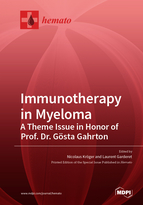Immunotherapy in Myeloma: A Theme Issue in Honor of Prof. Dr. Gösta Gahrton
A special issue of Hemato (ISSN 2673-6357). This special issue belongs to the section "Plasma Cell Disorders".
Deadline for manuscript submissions: closed (30 September 2021) | Viewed by 24926
Special Issue Editors
Interests: stem cell biology in myelofibrosis; allogeneic stem cell transplantation from unrelated donors; prevention and treatment of the donor-to-host response; cellular immunotherapy with genetically modified stem cells and T cells (CAR T cells); detection of minimal residual disease; molecular genetics in myeloid diseases; multiple myeloma; myelodysplastic syndromes
Interests: myeloma; AL amyloidosis; monoclonal gammopathy of clinical significance; POEMS; transplantation
Special Issues, Collections and Topics in MDPI journals
Special Issue Information
Dear Colleagues,
This Special Issue aims to honor the outstanding scientific career of Pr. Gösta Gahrton through a collection of manuscripts written by leading figures in the field of multiple myeloma immunotherapy. Thirty years ago, Pr Gahrton, along with the (EBMT) European Society for Blood and Marrow Transplantation when he was chairing the Myeloma Subcommittee of this organization, published a seminal paper reporting the outcome of allogeneic stem cell transplantation to treat multiple myeloma (N Engl J Med 1991; 325(18): 1267–73). Since then, the field of myeloma treatment, and especially the field of immune intervention, has moved dramatically. This Special Issue will cover all aspects ranging from the immunology of myeloma to different immune therapies. The immune biology of this particular bone marrow hematological malignancy will be presented. The broad spectrum of the different kinds of immune interventions, such as the allogeneic approach, the use of monoclonal antibodies including antibody–drug conjugates, and the new and very promising application of CAR T cells will also be reported on. As suggested by Pr Gahrton, immune therapy may be one step toward cure of multiple myeloma. This Special Issue will honor not only a great scientist but also a man of integrity who has been Chairman of the Nobel Committee of Karolinska Institutet.
Prof. Dr. Nicolaus Kröger
Dr. Laurent Garderet
Guest Editors
Manuscript Submission Information
Manuscripts should be submitted online at www.mdpi.com by registering and logging in to this website. Once you are registered, click here to go to the submission form. Manuscripts can be submitted until the deadline. All submissions that pass pre-check are peer-reviewed. Accepted papers will be published continuously in the journal (as soon as accepted) and will be listed together on the special issue website. Research articles, review articles as well as short communications are invited. For planned papers, a title and short abstract (about 100 words) can be sent to the Editorial Office for announcement on this website.
Submitted manuscripts should not have been published previously, nor be under consideration for publication elsewhere (except conference proceedings papers). All manuscripts are thoroughly refereed through a single-blind peer-review process. A guide for authors and other relevant information for submission of manuscripts is available on the Instructions for Authors page. Hemato is an international peer-reviewed open access quarterly journal published by MDPI.
Please visit the Instructions for Authors page before submitting a manuscript. The Article Processing Charge (APC) for publication in this open access journal is 1000 CHF (Swiss Francs). Submitted papers should be well formatted and use good English. Authors may use MDPI's English editing service prior to publication or during author revisions.
Keywords
- multiple myeloma
- the immune biology of myeloma
- immunotherapy
- allogeneic stem cell transplantation
- monoclonal antibody
- antibody–drug conjugate
- CAR T cell
- checkpoint inhibitor







